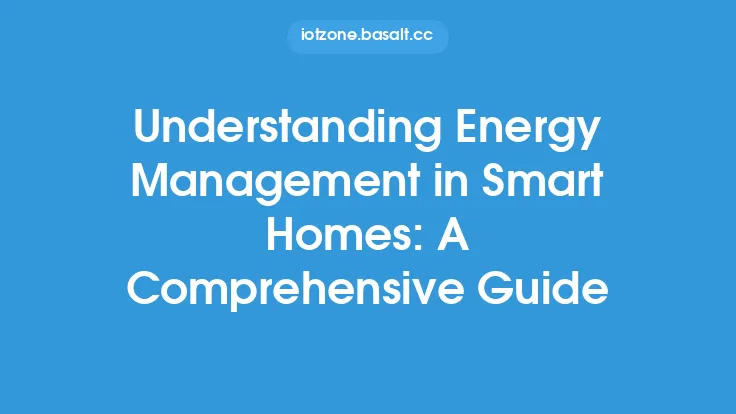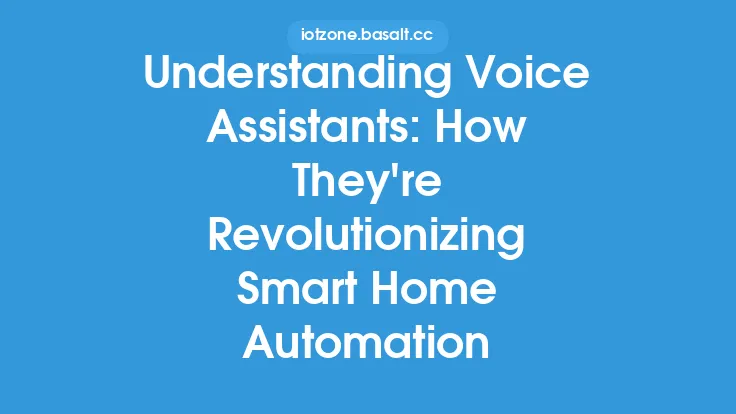The integration of voice assistants into smart home systems has revolutionized the way we manage and control our living spaces. One of the most significant benefits of using voice assistants in smart home automation is the ability to manage energy consumption efficiently. By leveraging the capabilities of voice assistants, homeowners can optimize their energy usage, reduce waste, and save on their utility bills. In this article, we will delve into the world of voice assistants for smart home energy management, exploring the various ways in which these devices can help homeowners save energy and reduce their carbon footprint.
Introduction to Voice Assistants for Energy Management
Voice assistants, such as Amazon Alexa, Google Assistant, and Apple Siri, have become an integral part of smart home automation. These devices use natural language processing (NLP) and machine learning algorithms to understand voice commands and control various smart devices in the home. When it comes to energy management, voice assistants can play a crucial role in optimizing energy consumption. By integrating with smart thermostats, lighting systems, and other energy-consuming devices, voice assistants can help homeowners monitor and control their energy usage in real-time.
How Voice Assistants Can Help with Energy Management
Voice assistants can help with energy management in several ways. Firstly, they can be used to control and schedule energy-consuming devices, such as lights, thermostats, and appliances. For example, homeowners can use voice commands to turn off lights, adjust the thermostat, or schedule their coffee maker to turn on at a specific time. Secondly, voice assistants can provide real-time energy usage data, allowing homeowners to monitor their energy consumption and identify areas of waste. This data can be used to optimize energy usage, reduce waste, and save on utility bills. Finally, voice assistants can be integrated with smart energy management systems, such as smart plugs and energy monitors, to provide a comprehensive view of energy usage and help homeowners make informed decisions about their energy consumption.
Smart Devices for Energy Management
To get the most out of voice assistants for energy management, homeowners need to invest in smart devices that can be controlled and monitored remotely. Some of the most popular smart devices for energy management include:
- Smart thermostats: These devices can be controlled remotely using voice commands, allowing homeowners to adjust the temperature, schedule heating and cooling, and optimize energy consumption.
- Smart lighting systems: These systems can be controlled using voice commands, allowing homeowners to turn lights on and off, adjust brightness, and schedule lighting scenes.
- Smart plugs: These devices can be used to control and monitor energy consumption of individual appliances, allowing homeowners to turn devices on and off, schedule usage, and monitor energy consumption in real-time.
- Energy monitors: These devices provide real-time energy usage data, allowing homeowners to monitor their energy consumption, identify areas of waste, and optimize energy usage.
Setting Up Voice Assistants for Energy Management
To set up voice assistants for energy management, homeowners need to follow a few simple steps. Firstly, they need to choose a voice assistant that is compatible with their smart devices. Secondly, they need to connect their smart devices to the voice assistant using a hub or bridge. Finally, they need to configure their voice assistant to control and monitor their smart devices. This can be done using the voice assistant's app or website, where homeowners can create custom scenes, schedules, and routines to optimize their energy usage.
Optimizing Energy Usage with Voice Assistants
To optimize energy usage with voice assistants, homeowners need to use a combination of voice commands, scheduling, and automation. For example, they can use voice commands to turn off lights, adjust the thermostat, and schedule their coffee maker to turn on at a specific time. They can also use scheduling to automate their energy usage, turning devices on and off at specific times of the day. Finally, they can use automation to optimize their energy usage, using voice assistants to control and monitor their smart devices in real-time.
Benefits of Using Voice Assistants for Energy Management
The benefits of using voice assistants for energy management are numerous. Firstly, they can help homeowners save energy and reduce their utility bills. Secondly, they can help homeowners reduce their carbon footprint and contribute to a more sustainable future. Thirdly, they can provide a convenient and user-friendly way to control and monitor energy usage, making it easier for homeowners to optimize their energy consumption. Finally, they can provide real-time energy usage data, allowing homeowners to make informed decisions about their energy consumption and identify areas of waste.
Challenges and Limitations of Using Voice Assistants for Energy Management
While voice assistants can be a powerful tool for energy management, there are several challenges and limitations to consider. Firstly, voice assistants require a stable internet connection to function, which can be a problem in areas with poor connectivity. Secondly, voice assistants can be prone to errors and misinterpretation, which can lead to incorrect commands and energy waste. Thirdly, voice assistants may not be compatible with all smart devices, which can limit their functionality and effectiveness. Finally, voice assistants can be vulnerable to hacking and cyber attacks, which can compromise the security and integrity of the smart home system.
Best Practices for Using Voice Assistants for Energy Management
To get the most out of voice assistants for energy management, homeowners should follow a few best practices. Firstly, they should choose a voice assistant that is compatible with their smart devices and provides a user-friendly interface. Secondly, they should configure their voice assistant to control and monitor their smart devices in real-time, using a combination of voice commands, scheduling, and automation. Thirdly, they should use real-time energy usage data to optimize their energy consumption, identifying areas of waste and making informed decisions about their energy usage. Finally, they should regularly update their voice assistant and smart devices to ensure they have the latest features and security patches.
Conclusion
In conclusion, voice assistants can be a powerful tool for smart home energy management, providing a convenient and user-friendly way to control and monitor energy usage. By leveraging the capabilities of voice assistants, homeowners can optimize their energy consumption, reduce waste, and save on their utility bills. While there are several challenges and limitations to consider, the benefits of using voice assistants for energy management far outweigh the drawbacks. By following a few best practices and choosing the right voice assistant and smart devices, homeowners can create a smart home energy management system that is efficient, effective, and sustainable.





